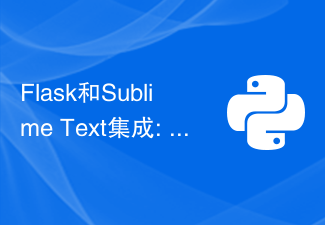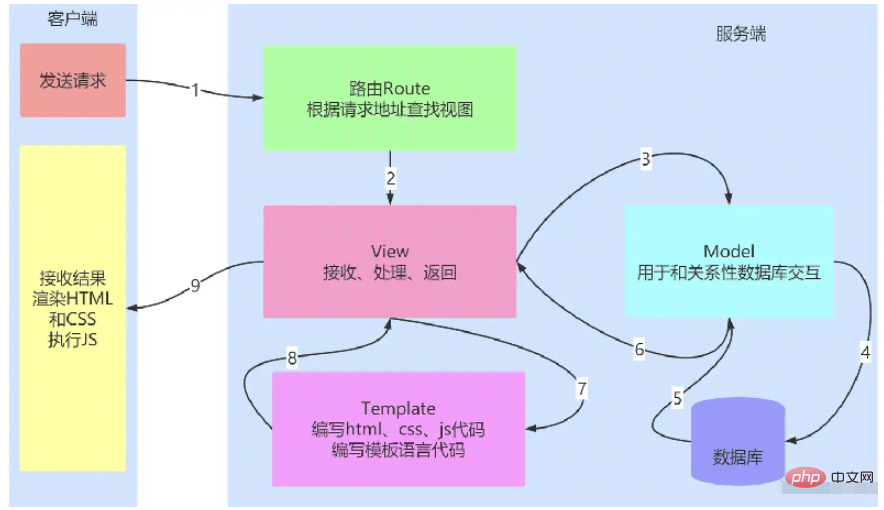 Backend Development
Backend Development Python Tutorial
Python Tutorial Flask-RESTful and Flask-JWT: User authentication and authorization in Python web applications
Flask-RESTful and Flask-JWT: User authentication and authorization in Python web applicationsIn modern web applications, user authentication and authorization are very critical security measures. With the popularity and usage of Python, Flask-RESTful and Flask-JWT have become the preferred solutions for user authentication and authorization in Python web applications. This article will introduce in detail the use of Flask-RESTful and Flask-JWT, and how to implement user authentication and authorization in Python web applications.
Introduction to Flask-RESTful
Flask-RESTful is an extension library of Flask that can help quickly build RESTful API interfaces. It provides many useful functions, such as input validation, request parsing, etc. With Flask-RESTful, we can easily build a simple Web API. Here is a simple example:
from flask import Flask
from flask_restful import Resource, Api
app = Flask(__name__)
api = Api(app)
class HelloWorld(Resource):
def get(self):
return {'hello': 'world'}
api.add_resource(HelloWorld, '/')
if __name__ == '__main__':
app.run(debug=True) In this example, we create a resource named HelloWorld and add it to api in the object. Finally, we can access the HelloWorld resource through the / route. When we access the / route, call the get method of the HelloWorld resource and return a JSON response {'hello': 'world'}.
Introduction to Flask-JWT
Flask-JWT is another extension library for Flask for implementing JSON Web Token (JWT) authentication in web applications. JWT is an open standard for securely transmitting information between users and servers. It is based on JSON and usually consists of three parts, namely header, payload and signature. The header contains the JWT type and algorithm information used, the payload contains the data information that needs to be transmitted, and the signature is used to verify whether the data is correct. Flask-JWT simplifies the generation and verification of JWT, making it easier to implement user authentication in web applications. Here is a simple example:
from flask import Flask
from flask_jwt import JWT, jwt_required, current_identity
from werkzeug.security import safe_str_cmp
app = Flask(__name__)
app.config['SECRET_KEY'] = 'super-secret'
class User(object):
def __init__(self, id, username, password):
self.id = id
self.username = username
self.password = password
def __str__(self):
return f"User(id='{self.id}', username='{self.username}')"
users = [
User(1, 'user1', 'password'),
User(2, 'user2', 'password')
]
username_table = {u.username: u for u in users}
userid_table = {u.id: u for u in users}
def authenticate(username, password):
user = username_table.get(username, None)
if user and safe_str_cmp(user.password.encode('utf-8'), password.encode('utf-8')):
return user
def identity(payload):
user_id = payload['identity']
return userid_table.get(user_id, None)
jwt = JWT(app, authenticate, identity)
@app.route('/protected')
@jwt_required()
def protected():
return {'hello': current_identity.username}
if __name__ == '__main__':
app.run(debug=True)In this example, we first define a User class to store the user's authentication information. In the authenticate function, enter a username and password, and the function will return a user object. In the identity function, enter a jwt payload, and the function will return a user object based on the user id in the jwt. By calling the JWT constructor, we add a custom authentication method and a custom user identification method to the application. Finally, the @jwt_required decorator is used in the protected route's decorator to ensure that only authenticated users can access protected resources.
The combination of Flask-RESTful and Flask-JWT
We can use Flask-RESTful and Flask-JWT together to implement a complete web application, including user authentication and authorization mechanisms. The following is a simple example:
from flask import Flask
from flask_restful import Resource, Api, reqparse
from flask_jwt import JWT, jwt_required, current_identity
from werkzeug.security import safe_str_cmp
app = Flask(__name__)
app.config['SECRET_KEY'] = 'super-secret'
api = Api(app)
class User(object):
def __init__(self, id, username, password):
self.id = id
self.username = username
self.password = password
def __str__(self):
return f"User(id='{self.id}', username='{self.username}')"
users = [
User(1, 'user1', 'password'),
User(2, 'user2', 'password')
]
username_table = {u.username: u for u in users}
userid_table = {u.id: u for u in users}
def authenticate(username, password):
user = username_table.get(username, None)
if user and safe_str_cmp(user.password.encode('utf-8'), password.encode('utf-8')):
return user
def identity(payload):
user_id = payload['identity']
return userid_table.get(user_id, None)
jwt = JWT(app, authenticate, identity)
class HelloWorld(Resource):
def get(self):
return {'hello': 'world'}
class Secret(Resource):
@jwt_required()
def get(self):
return {'secret': 'resource', 'user': current_identity.username}
class Login(Resource):
def post(self):
parser = reqparse.RequestParser()
parser.add_argument('username', type=str, help='Username cannot be blank', required=True)
parser.add_argument('password', type=str, help='Password cannot be blank', required=True)
args = parser.parse_args()
user = authenticate(args['username'], args['password'])
if user:
return {'access_token': jwt.jwt_encode_callback({'identity': user.id})}
else:
return {'message': 'Invalid username or password'}, 401
api.add_resource(HelloWorld, '/')
api.add_resource(Secret, '/secret')
api.add_resource(Login, '/login')
if __name__ == '__main__':
app.run(debug=True) In this example, in addition to defining the HelloWorld resource, we also define the Secret resource and Loginresource. In the Secret resource, pass the @jwt_required decorator to ensure that only authenticated users have access. In the Login resource, we parse the POST request and use the authenticate function to verify the user's identity information. If the verification is successful, the JWT token is returned, otherwise a 401 status code is returned. Finally, we added all the resources to the api object and started the web application using Flask's run method.
Summary
In Python web application development, Flask-RESTful and Flask-JWT are very useful extension libraries. Through them, we can easily build and secure Web APIs and add user authentication and authorization mechanisms to web applications. Using Flask-RESTful and Flask-JWT can reduce our development time and development costs, making it easier for us to implement the functions of web applications.
The above is the detailed content of Flask-RESTful and Flask-JWT: User authentication and authorization in Python web applications. For more information, please follow other related articles on the PHP Chinese website!
 Flask + Vue.js:快速实现单页面应用Jun 17, 2023 am 09:06 AM
Flask + Vue.js:快速实现单页面应用Jun 17, 2023 am 09:06 AM随着移动互联网和Web技术的迅速发展,越来越多的应用需要提供流畅、快速的用户体验。传统的多页面应用已经无法满足这些需求,而单页面应用(SPA)则成为了解决方案之一。那么,如何快速实现单页面应用呢?本文将介绍如何利用Flask和Vue.js来构建SPA。Flask是一个使用Python语言编写的轻量级Web应用框架,它的优点是灵活、易扩
 如何使用python+Flask实现日志在web网页实时更新显示May 17, 2023 am 11:07 AM
如何使用python+Flask实现日志在web网页实时更新显示May 17, 2023 am 11:07 AM一、日志输出到文件使用模块:logging可以生成自定义等级日志,可以输出日志到指定路径日志等级:debug(调试日志)=5){clearTimeout(time)//如果连续10次获取的都是空日志清除定时任务}return}if(data.log_type==2){//如果获取到新日志for(i=0;i
 Flask和Intellij IDEA集成: Python web应用程序开发技巧(第二部分)Jun 17, 2023 pm 01:58 PM
Flask和Intellij IDEA集成: Python web应用程序开发技巧(第二部分)Jun 17, 2023 pm 01:58 PM在第一部分介绍了基本的Flask和IntellijIDEA集成、项目和虚拟环境的设置、依赖安装等方面的内容。接下来我们将继续探讨更多的Pythonweb应用程序开发技巧,构建更高效的工作环境:使用FlaskBlueprintsFlaskBlueprints允许您组织应用程序代码以便于管理和维护。Blueprint是一个Python模块,能够包
 Flask-RESTful和Swagger: Python web应用程序中构建RESTful API的最佳实践(第二部分)Jun 17, 2023 am 10:39 AM
Flask-RESTful和Swagger: Python web应用程序中构建RESTful API的最佳实践(第二部分)Jun 17, 2023 am 10:39 AMFlask-RESTful和Swagger:Pythonweb应用程序中构建RESTfulAPI的最佳实践(第二部分)在上一篇文章中,我们探讨了如何使用Flask-RESTful和Swagger来构建RESTfulAPI的最佳实践。我们介绍了Flask-RESTful框架的基础知识,并展示了如何使用Swagger来构建RESTfulAPI的文档。本
 Flask和Sublime Text集成: Python web应用程序开发技巧(第六部分)Jun 17, 2023 pm 04:08 PM
Flask和Sublime Text集成: Python web应用程序开发技巧(第六部分)Jun 17, 2023 pm 04:08 PMFlask和SublimeText集成:Pythonweb应用程序开发技巧(第六部分)SublimeText和Flask都是Pythonweb应用程序开发中的重要工具。然而,如何将二者集成起来,使得开发过程更加高效呢?本文将介绍一些SublimeText的插件和配置技巧,帮助你更方便地开发Flask应用程序。一、安装SublimeText插件F
 Flask和Eclipse集成: Python web应用程序开发技巧(第三部分)Jun 17, 2023 pm 03:27 PM
Flask和Eclipse集成: Python web应用程序开发技巧(第三部分)Jun 17, 2023 pm 03:27 PMFlask和Eclipse集成:Pythonweb应用程序开发技巧(第三部分)在前两篇文章中,我们介绍了如何将Flask与Eclipse集成,以及如何创建Flask应用程序。在本文中,我们将继续探讨如何开发和调试Flask应用程序,以及如何管理数据库。一、开发和调试Flask应用程序创建和运行Flask应用程序在Eclipse的ProjectExplo
 Flask-Security: 在Python web应用程序中添加用户身份验证和密码加密Jun 17, 2023 pm 02:28 PM
Flask-Security: 在Python web应用程序中添加用户身份验证和密码加密Jun 17, 2023 pm 02:28 PMFlask-Security:在Pythonweb应用程序中添加用户身份验证和密码加密随着互联网的不断发展,越来越多的应用程序需要用户身份验证和密码加密来保护用户数据的安全性。而在Python语言中,有一个非常流行的Web框架——Flask。Flask-Security是基于Flask框架的一个扩展库,它可以帮助开发人员在Pythonweb应用程序中轻
 Python Flask JinJa2语法如何使用May 16, 2023 am 09:19 AM
Python Flask JinJa2语法如何使用May 16, 2023 am 09:19 AM一、概述Flask是一个轻量级的PythonWeb框架,支持Jinja2模板引擎。Jinja2是一个流行的Python模板引擎,它可以使用Flask来创建动态Web应用程序。web页面一般需要html、css和js,可能最开始学习pythonweb的时候可能这样写:fromflaskimportFlaskapp=Flask(__name__)@app.route('/')defhello():return'hellohelloworld!!!&am


Hot AI Tools

Undresser.AI Undress
AI-powered app for creating realistic nude photos

AI Clothes Remover
Online AI tool for removing clothes from photos.

Undress AI Tool
Undress images for free

Clothoff.io
AI clothes remover

AI Hentai Generator
Generate AI Hentai for free.

Hot Article

Hot Tools

Safe Exam Browser
Safe Exam Browser is a secure browser environment for taking online exams securely. This software turns any computer into a secure workstation. It controls access to any utility and prevents students from using unauthorized resources.

ZendStudio 13.5.1 Mac
Powerful PHP integrated development environment

SublimeText3 English version
Recommended: Win version, supports code prompts!

Zend Studio 13.0.1
Powerful PHP integrated development environment

Dreamweaver CS6
Visual web development tools





